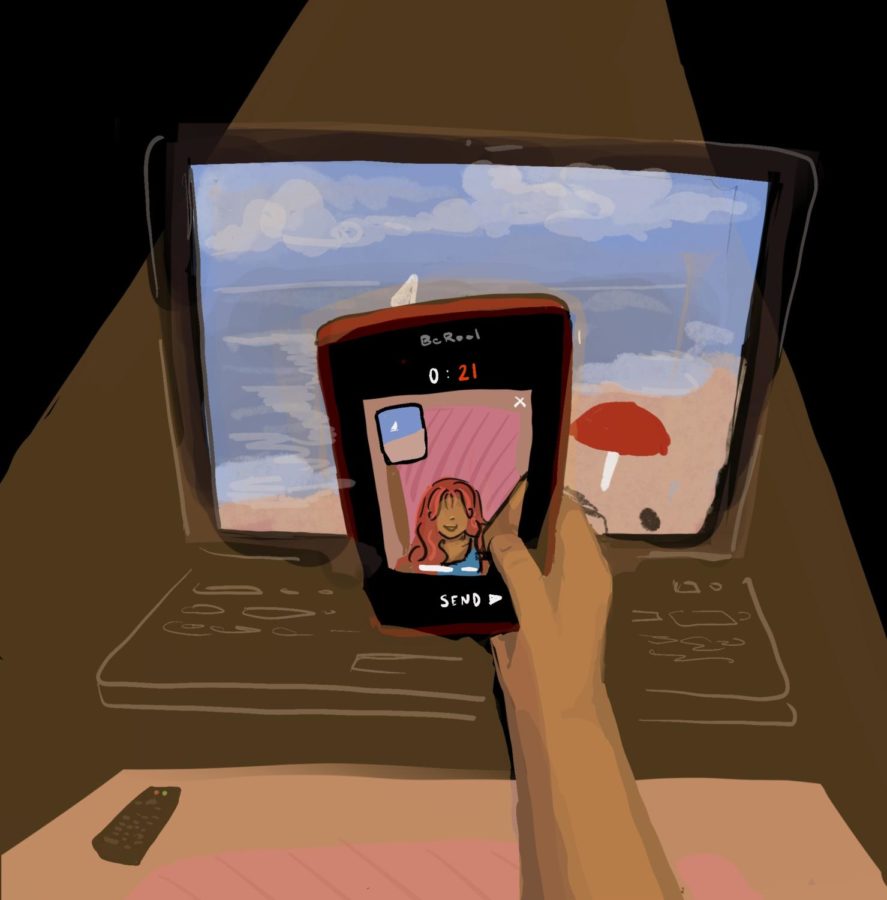Opinion | Curating authenticity in the age of Be(ing)Real
November 10, 2022
“recipe for a perfect photo dump:
- fire selfie
- outfit pic
- candid pic w ur partner or friends
- food
- BeReal
- screenshot(s) (a text, a song you’ve had on repeat)
- camcorder moment or vid screenshot
- horizontal photo posted vertically
- personality pic
- ~very~ candid/effortless photo”
This is the to-do list I was greeted with: screenshotted from a TikTok user, posted on Instagram, glaring at me from my feed. I admit, I leapt at the opportunity. Immediately, the little synapses in my brain started firing, and I hunted through my recent camera roll to find pictures that would satisfy each of these requirements. What could be more appealing than selecting the shiniest pieces of yourself and showing them off? At this moment, carefully choosing these photos, I have complete control over how I am perceived, which facets of myself I want to highlight and what overall character I would like to curate for myself, to be seen by others. Best of all, the photo dump itself seems to imply authenticity, so my selected images will come off even more candid and genuine, even though I am quite literally following a formula. This thought is thrilling, and then it’s not. Soon, the pressure becomes daunting, and a little terrifying. I often pause in moments when I’m torn between which screenshot of an arcane acoustic ballad I should post, and think, “What in the world am I doing?”
How are we handling the newfound platforms we’ve all received from social media? It’s a stranger reality than I believe we often credit it to be; with our social media accounts, the subtle performances we give to our followers eventually square us into a brand that we then have to maintain. This was a responsibility priorly reserved for actual brands, then celebrities and online personalities striving to maintain an audience. Now, any average person with more than 10 followers is subject to the sensation of perception, even if only on the smallest scale, and the urge to control this perception as much as possible.
Senior Lily Benjamin reflects on the information she’s shared about herself online, saying “…It’s not like you’re sharing actual, personal information about, like, what makes you you…It’s just how you want to be perceived, even if it isn’t, like, necessarily a positive thing, but I don’t know. I don’t know why.”
Often, thinking back on my own online presence, I have a similar reaction; I don’t quite know why I post the things that I do, or where the appeal in posting random information about myself, like which fictional characters I relate to the most, comes from.
A fellow senior at ETHS adds, “Everyone is guilty of this; wanting to have, like, a defined, set personality. Like, are you the funny friend? Are you the main character? Are you the love interest?” This student is discussing specifically how the need to have a concrete self-image presented online affects teenagers, still unsure of who they really are.
Projecting an idealized version of yourself is an instinct as old as social culture, but being online greatly exacerbates the pressure to perform and being a teenager online is even worse. It’s incentivized to have an image of who you’d like to be, advertised to everyone as who you actually are. Social media has become an outlet of anti-authenticity, and its methods have become quite complex.
Consider BeReal. It seems like a haven of human connection in our superficial Internet realm. Everything in the app’s design functions with the sole purpose of eliminating the curation process and highlighting what we’re really doing in our day to day lives. For those unfamiliar with the app, BeReal is an image sharing platform that has gained popularity recently for its centering of the mundane elements of our lives, rather than the glamorized. Users are notified once daily that it is, in fact, time to be real, at which point they have two minutes to take a photo of whatever they’re doing at that moment. If a user fails to post within two minutes of the notification, their post for the day will be marked late, by however many hours. BeReal also has a feature that marks each post with the number of times the user retook the photo. The senior student, a user of the app, says “They expose you if you’re not real. But like, the thing is…people would be like, ‘Oh, I’m going to a concert tonight. I’ll specifically post late.’ Like, no one ever posts on time.”
Despite the app’s many attempts to avoid idealized images on their platform, the desire to curate is pervasive, because we are so embedded in this culture already. Even when faced with a time limit, the persistent user will find a way to spruce up whatever they happened to be doing when they received the notification. Sitting in your room suddenly becomes reading poetry, for instance. If you’re doing something more photo-worthy later, nobody really notices the late post mark; because of how the app is marketed, everything on it seems to have some air of being in the moment, even if it’s 20 hours late. While it seems like a good thing that we have such a popular social media site countering the superficiality of other platforms, there is something insidious about their incessant reminders that the app is authentic. As video essayist Amanda Maryanna says in her video, “the art of being real”, “…thanks to our newfound affinity for the effortless aesthetic, it’s harder than ever to distinguish the candid from the curated.” BeReal seems the antithesis of that formulaic list that will result in a “perfect photo dump,” although they both have the same goal; to give the illusion of having an effortlessly beautiful life, at all times. When picturesque, enviable images are posted on BeReal, the impression that this is what the poster’s life is like 24/7 and the subsequent comparing and jealousy other users might experience, is significantly stronger than it would be on any other app. BeReal is just as much of a performance as Instagram; the only difference is how they’re marketed.
It’s evident that the urge to be perceived in some specific way is pretty inescapable for the majority of us, to the point that an app explicitly titled BeReal can become yet another vehicle for, well, fakeness. The sacrifices, however, that come with maintaining some constructed brand online are considerable. As senior Lily Straussman says, “It all wraps back to consumerism. Like, these different looks and, like, models of human beings that are so fake, that people create…and then push it out to these kids who are already trying to make themselves look cooler than they are because they [feel pressured] to. It’s like a cycle that never ends.”
Straussman also references the “microtrends of 2020 and 2021,” an online phenomenon of rapidly changing, hyperniche clothing trends marketed to primarily teen users as a piece of some larger “aesthetic”. “. . .the polka dot pants or the cow print pants. I never really was into that, cause it was so fake, and I just knew that it would be over soon,” Straussman says. These clothes were mostly found on fast fashion websites like Shein and Romwe, which unethically produce clothes at breakneck speed in order to keep up with the amazingly short-lived trends of the period. Microtrends became such a mainstream problem because of the demand that social media facilitates for clothes. Clothes can be such a clear indicator of the characters we want to play online. They are the primary symbol of other online figures that we remember and try to emulate. A chunky sweater microtrend may be incited because of a handful of influencers proclaiming the rise of the “grandpa aesthetic” (this was a real thing, I promise you). Shein may suddenly start producing crochet pieces in bulk because of the “hippie aesthetic” gaining traction. Benjamin says, “…the corset trend, or whatever, like, that was completely, like, a social media thing, because I never really saw people…wearing corsets to school.“ Social media can pump out new random patterns, colors or fashion pieces daily and declare it a necessary wardrobe staple, and by tying it to certain lifestyles and identities (leather jacket = cool girl, cream colors = light academia, chunky rings = astrology girl), they can prey on teen users from their most vulnerable point; trying to understand who they are. That way, teens overconsume arbitrary items of clothing, not simply to look nice, but to signal to the world some constructed identity. In some way, we are defining ourselves by the materials we own or consume. In August 2021, I posted a TikTok pretty much just word-vomiting things I liked, and really wanted people to know I liked. Moonstone, iced coffee, tarot, fall-scented stuff, World Market and pearls were featured on the list, as if those are adjectives to describe me and not just a long list of consumable items; a shopping list. It seems fitting that another mention was “retail therapy.”
The constant need to define ourselves is very real, especially when we struggle with having security in who we are. Staussman says, “…people need to be able to define themselves with something.” The senior student adds, when I asked them about a Tik Tok trend from a while ago where people were randomly declaring if they were the color blue or the color red, “That’s why [teenagers]…take character tests or do Buzzfeed quizzes. It’s because they don’t know anything really about themselves, and when people do find themselves…it almost feels like, ‘Oh, I’m being self-absorbed to dictate myself in this way or see myself in this way.’ And I think people want validation…from being like, ‘Oh my God, you are the color blue!!’ Because that means in some little way you are right about who you are.” This vulnerability is commodified as an opportunity for profit by not only social media platforms, but large companies pandering to teens as well. We don’t quite know who we are yet, and so given a platform, we have a chance to project into the world a clear, consistent, branded identity through our curation and consumption. It’s a comfort thing, or, as the senior student says, “an identity thing”, and it’s a comfort which is taken advantage of largely.
So, then, how do we cope with these things? It’s sort of impossible to say. A problem as complex as this is not a quick fix. I believe simply bringing awareness to these things is all we need to make a giant first step towards taking the validation we get from social media off its pedestal. Benjamin talks about how social media has slowly lost its influence over her life, saying, “…If I’m, like, out with friends…I feel like I don’t necessarily need to, like, take pictures with them and stuff, because, like, in reality, it takes time out of…what I’m spending with them.” Straussman adds, “I just started kind of posting what I wanted to post…I honestly think it was just growing up, because I would take these really cool photos…but I’d be like, ‘Oh, it’s not of myself’, or, ‘It’s of, like, the sky, like who wants to see that?’ And I was like, I want people to see it…I like it.” Being aware of the ways that curated social media platforms affect us, both as creators and consumers, begins to slowly expose the fakeness of it all. In short, when you know there’s a game being played, it becomes much less necessary to play it.











